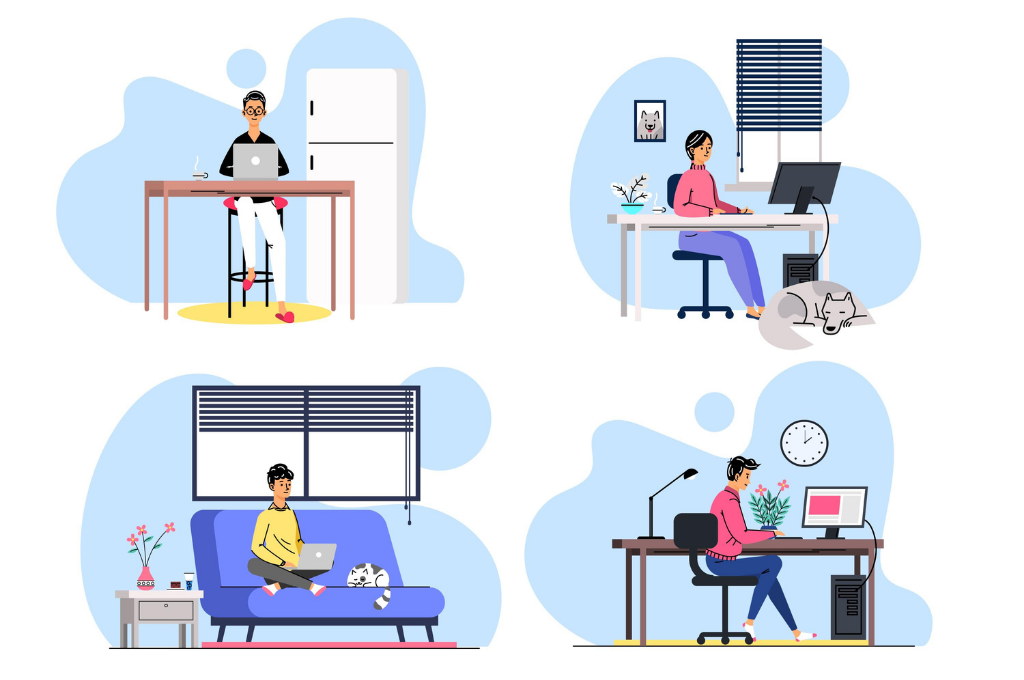In the wake of the Corona situation, businesses found a considerable disruption in their working practices. These changes remain in continuity even in the post-pandemic era, where employers think of returning to the new normal by calling back their employees in the workplace.
Gone are the days when strict 9 to 5 job schedules, a desk-bound workforce, and limited technology systems were adopted in the workplace. With the immediate shift to remote work, the way of working is completely changing to a new model. Today, the traditional workplaces are replaced with digital and hybrid ones to welcome the employees rightly and more safely in the post-pandemic era.
In this article, we will talk over the hybrid working model and its adoption by the companies in the new-normal condition.
Ways To Form A New And Updated Workplace In Post-Pandemic
Today the post-pandemic work status does not only consist of complete WFH or WFO. Rather it’s a combination of both called hybrid work where employees partially come to the office and partly perform their job remotely. Though organizations are confounded in the hybrid vs. fully remote work, many employers are going with the hybrid option to give flexibility to their employees. The figure below shows the same situation-
Thus the image clearly shows the gradual shift to a fusion of remote and office work culture to ensure employees’ health and safety concerns.
But such a work environment in the organization demands a considerable restructuring process, as shown in the figure below-
This redesigning process in the workplace requires changes in terms of the tools, technology, and infrastructure. Why? Because hybrid work is far more than just a laptop at home, a desktop system at the office, and a strong internet connection. This clearly shows that the present technological stack is not ready enough to enter the post-pandemic workplace.
Thus, lets in the following points check out the post-pandemic workplace essentials required in the new-normal work condition-
1. Determine Employee's Post-Pandemic Work Preferences
This is the first and foremost facet to consider while restructuring the workplace in the post-pandemic era. Knowing what the workforce thinks about returning to the office will frame a proper and researched outline to embrace the hybrid work model.
In the coming time, a 3-2-2 work pattern might come forward. Here, the workforce will work three days in the office, two days remotely, and enjoy two days of holidays. Adopting such a model will ensure employees’ flexibility, productivity, job satisfaction, and connectivity with the workplace.
But without receiving confirmation from the employee’s side, it isn’t very worthy of thinking about designing a perfect new-normal workplace. For doing the same, you can ask the following questions to the workforce-
- How do you imagine your work situation in the post-pandemic?
- For how many days would you like to come to the office premises?
- Do you desire any activities or processes to keep remote?
- Are there certain meetings to conduct in-person only?
- Do you wish to come to the office on specific days only?
- How do you prefer to collaborate with others?
Getting responses to all these questions will give a better opportunity to restructure the business and workplace concerning employee feedback. Making such efforts will keep the employees productive and happy enough to perform their job, ultimately helping to attract and retain the best talents.
2. Emphasize More Security Measures
Both hybrid and work from anywhere models require better security tools to keep themselves away from cyberattacks. This is because all organizations are worried about the public and unsafe Wi-Fi networks, as they are more vulnerable than secured office networks. Thus, your returning policy to the workplace should comprise an updated security policy and tools usage. This demands businesses to increase security measurement budgets. It includes both hardware and software spending that demand better firewalls, anti-virus solutions, and content-filtering practices.
Apart from this, other security steps are also essential to consider in the new working model. Some of them are mentioned below-
-
Reinforce security awareness in all the employee’s minds, forming a secure hybrid workforce.
-
Ensure to conduct data backup and testing processes and store them in secured cloud infrastructure.
-
Perform constant monitoring of all the devices and determine the consumption patterns to get early security alerts.
-
Upscale collaboration security
-
Embrace zero-trust networking access
3. Support Better Attendance Marking Options
Will this be a pivotal necessity to look for in the hybrid working model? Surely it is as, in the new working model, some employees will work from the office premise while others remotely. Therefore, the traditional presence marking approaches will not remain an effective practice to follow. This demands an identical solution inclusive to all the employees for marking their attendance in this new-normal workplace.
With technological advancement, geo-tracking, geo-fencing, and face recognition are becoming in-built functionalities of the online attendance management solution that help employees punch authentically. Both remote workers and in-office employees can use this practice to hassle-freely mark their attendance. Such a contamination-free attendance marking approach will motivate the employees enough to come to the office to perform their jobs. This further helps employers observe and store their attendance regardless of punching methods.
Having such a digitized solution in the hybrid workplace will help to rightly compensate employees by noting the total working hours while partially WFH and WFO.
4. Enhance Communication And Collaboration Among The Team
Similar to the remote work model, in the post-pandemic workplace, there is a need for proper communication and collaboration channels among all the employees. Now the working practices are not entirely remote or WFO based. Thus, all organizations must reframe communication strategies to ensure that both on-premise and off-premise employees collaborate well.
To do the same, many companies adopt systems and tools to avoid the cases of misconception, false data, and insufficient knowledge-sharing. The remote working tools useful for collaboration purposes include Slack, Zoom, Microsoft Teams, Google Meet, and other Software-as-a-Service (SaaS) or Desktop-as-a-Service (DaaS) products, which bridges the communication gap by getting involved in the hybrid meetings and work culture.
Gartner’s study also revealed about 44% of the increase in the use of collaboration tools from 2019. A pictorial representation of the same is shown in the figure below-
Adopting the same in the hybrid work model will help make all employees’ jobs much simplified and communicative.
On the other side, if most of the employees are partly performing from the office, it is worth refabricating the office with better collaboration spaces.
Many companies are already coming up with new and renowned ideas for establishing a distance collaboration culture. Let’s explore some of them.
-
Dropbox, a leading file hosting service provider, allows complete remote work while keeping the office space only for collaboration purposes.
-
Google, a bigwig multinational technology company, updated the features of Google Workspace, which includes sidebar chat, hand raises, polls, and live captions. This will help both remote and in-office employees’ participation, facilitating better collaboration among the team.
-
WeTransfer, the file-sharing service, removed about half of the desks for their office spaces to get more area for developing meeting rooms and workshop spaces.
At the beginning stage, it may demand more effort in setting up a proper collaborative workplace. But, once done correctly will form a perfect hybrid workplace for your organization.
5. Focus On Employee's Safety First
While calling the employees in the hybrid mode of working, consider their health and safety at the prior level. The figure below shows the health and safety concerns of the employees-
Companies need to make them feel safe while working in the workplace. This demands to look for the following metrics-
- Undergo risk assessment for the workforce demographics
- Update safety protocols with the government’s COVID-19 precaution guidelines
- If required, connect with medical professionals to understand the medical measures
- Perform adequate sanitation in the work premises
Moreover, as per Deloitte’s research, the return intention drivers of employees are vaccination states, transportation (in and out from work), inclination, and sanitation.
This demands to think about all the touchpoints of the employees inside the office premises to let them feel safer. Here, the technological solutions help develop a safety culture where you can adopt a touchless entrance system, automatic wellness verification setup, check out building security. Leveraging such touchless controls will eliminate the congestion and build a proper social-distancing workplace.
Be Ready For The Restructured Workplace
The impact of the global pandemic is gradually decreasing, but it is still present. This demands all business owners to adopt the rethink, redesign, retool approach for developing a hybrid workplace in the post-pandemic world. In this work condition, as companies need to work in a partial office and remote setup, some reframed digital strategies are required to initiate.
Thus, it’s time to say big thanks to the technological evolution that appreciates the hybrid and digital workplace culture. Besides that, do not forget to consider employees’ emotions, recognition, and well-being importance to develop an “employee-centric” workplace. So it’s time to draw attention to all the potent restructuring tactics mentioned above with the best technology and tools adoption for flourishing your business.


























